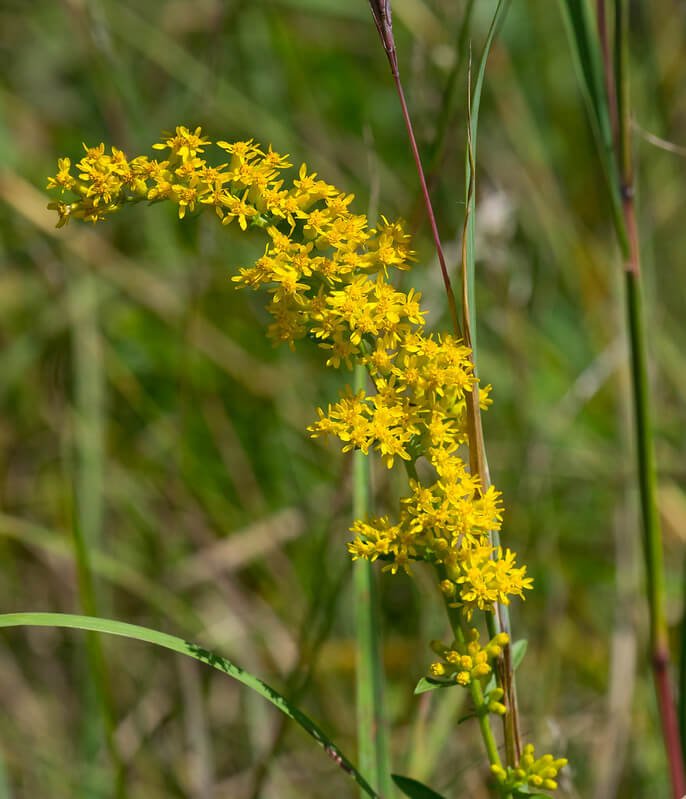Old Field Goldenrod (Solidago nemoralis)
Old Field Goldenrod (aka Gray Goldenrod) has an extraordinary value for pollinators. The nectar and pollen of the flowers attract a wide variety of insects, especially native bees (illinoiswildflower.info). It is the host plant to 135 species of butterflies and moths in our area (nwf.org) as well as the host to an incredible 43 specialist bees (Johnson and Colla, 2023). The Xerces Society also considers it a preferred pollinator plant (Xerces.org). This is a great plant for those infertile, hot, dry spots where little else grows. There are mixed reviews when it comes to the spreading habits of Old Field Goldenrod. Mine has barely spread at all, but it is not in its ideal location. Some sites say that it can spread aggressively, so just be aware of its potential to spread. I would be happy to hear how yours are growing. Goldenrods in general provide so many ecosystem services even when most other plants are shutting down for the season. Just something to keep in mind, goldenrods do not cause hay fever! Their pollen is too heavy, it is the wind-pollinated (but not as visually obvious) ragweed that causes it.
Photo credit: Joshua Mayer
Old Field Goldenrod (aka Gray Goldenrod) has an extraordinary value for pollinators. The nectar and pollen of the flowers attract a wide variety of insects, especially native bees (illinoiswildflower.info). It is the host plant to 135 species of butterflies and moths in our area (nwf.org) as well as the host to an incredible 43 specialist bees (Johnson and Colla, 2023). The Xerces Society also considers it a preferred pollinator plant (Xerces.org). This is a great plant for those infertile, hot, dry spots where little else grows. There are mixed reviews when it comes to the spreading habits of Old Field Goldenrod. Mine has barely spread at all, but it is not in its ideal location. Some sites say that it can spread aggressively, so just be aware of its potential to spread. I would be happy to hear how yours are growing. Goldenrods in general provide so many ecosystem services even when most other plants are shutting down for the season. Just something to keep in mind, goldenrods do not cause hay fever! Their pollen is too heavy, it is the wind-pollinated (but not as visually obvious) ragweed that causes it.
Photo credit: Joshua Mayer
Old Field Goldenrod (aka Gray Goldenrod) has an extraordinary value for pollinators. The nectar and pollen of the flowers attract a wide variety of insects, especially native bees (illinoiswildflower.info). It is the host plant to 135 species of butterflies and moths in our area (nwf.org) as well as the host to an incredible 43 specialist bees (Johnson and Colla, 2023). The Xerces Society also considers it a preferred pollinator plant (Xerces.org). This is a great plant for those infertile, hot, dry spots where little else grows. There are mixed reviews when it comes to the spreading habits of Old Field Goldenrod. Mine has barely spread at all, but it is not in its ideal location. Some sites say that it can spread aggressively, so just be aware of its potential to spread. I would be happy to hear how yours are growing. Goldenrods in general provide so many ecosystem services even when most other plants are shutting down for the season. Just something to keep in mind, goldenrods do not cause hay fever! Their pollen is too heavy, it is the wind-pollinated (but not as visually obvious) ragweed that causes it.
Photo credit: Joshua Mayer
Life Cycle: Perennial
Sun Exposure: Full, Partial (Seems to prefer Full Sun)
Soil Moisture: Medium-dry, Dry
Height: 1-2.5 feet
Plant Spacing: 1-2 feet
Bloom Time: August-September
Bloom Color: Yellow
Advantages: Caterpillar Favorite, Pollinator Favorite, Bird Favorite, Deer Resistant, Great Landscape Plant
Host Plant: 135 species of butterflies and moths use this as a caterpillar host plant in our area (nwf.org) (illinoiswildflower.info)
Specialist Bee: Andrena aliciae, A. apacheorum, A. asteris, A. braccata, A. canadensis, A. chromotricha, A. hirticincta, A. nubecula, A. placata, A. simplex, Perdita octomaculata, P. swenki, Pseudopanurgus aestivalis, P. andrenoides, P. compositarum, P. labrosiformis, P. solidaginis, Melissodes agilis, M. boltoniae, M. coloradensis, M. coreopsis, M. dentiventris, M. druriellus, M. fumosus, M. illatus, M. menuachus, M. microstictus, M. niveus, M. trinodis, M. wheeleri, Colletes americanus, C. compactus, C. rufocinctus, C. simulans, C. solidaginis, C. speculiferus, Dieunomia heteropoda, Dianthidium simile, Dufourea marginata, Megachilie inimical, M. parallela, M. xylocopoides, and Ashmeadiella bucconis. (Johnson and Colla, 2023)
Resource: Johnson, Lorraine, and Sheila Colla. A Northern Gardener’s Guide to Native Plants and Pollinators: Creating Habitat in the Northeast, Great Lakes, and Upper Midwest. Island Press, 2023







